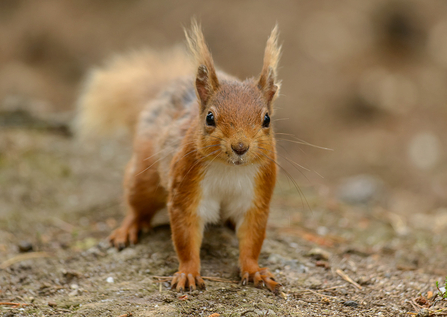The surveys take place in ‘red squirrel counties’ across northern England, where wild red squirrels can still be found: in Cumbria, Northumberland, Tyne & Wear, North Yorkshire, Lancashire, Merseyside and parts of County Durham.
As with previous years, over 125 people were involved in this massive citizen science project surveying 253 sites including woodlands and gardens across seven counties with many of the surveys carried out by volunteers using trail cameras, feeders in gardens and walking through forests to spot squirrels.
In Northumberland, the number of red squirrels recorded catapulted by 19% to 44.7% from 2019’s 26%, which are the rewards form the long-term and sustained efforts invested by our rangers and local volunteers. Notably the increase in the Harwood and Kielder red squirrel strongholds, where the natural defence of conifer forests provide some help in slowing down the greys, bolstered county results.
Grey squirrel numbers were also up - from 51% to 62.3%, most likely due to favourable environmental factors such as mild winters and good autumn crops, both of which favour grey squirrel reproduction.
Most encouraging from this year’s survey results is red squirrel occupancy across the red squirrel regions has remained stable since 2015 - it is not down, but up! However, there is no room for complacency, as grey squirrel occupancy is also up and very high at around 60% on average.
Management of grey populations remains vital in order to protect the native reds so that they can continue to thrive, which they surely would not be doing if grey management was not at its current level, especially thanks to the significant efforts of local community volunteers.
The survey is a time-consuming and costly exercise costing RSNE £1,000s each year for materials, contractors and coordination time and would be much higher if local volunteers and squirrel groups didn’t help so much. Anybody wishing to support the work of RSNE can do so by visiting: www.nwt.org.uk/join/fors-membership-form
Speaking about the survey results, Heinz Traut, RSNE Project Manager says: “Although the number of red squirrels has risen, so have the number of grey squirrels, so it is vital that we don’t see a drop in conservation effort and hold the line until developments such as grey fertility control materialise in a few years.
“The results from previous years’ annual surveys show that what we are collectively doing to protect reds in the north of England is working, but it needs to be long-term with continued support if we are to continue to protect this wonderful little animal. We would welcome your support through joining our Friends of the Red Squirrel membership programme.”
Grey squirrels out-compete reds for food and carry a fatal virus, squirrel pox virus, which they are immune to. Over 99% of reds known to catch the virus die within two weeks.

